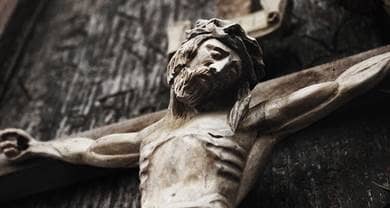- Trending:
- Pope Leo Xiv
- |
- Israel
- |
- Trump
- |
- Social Justice
- |
- Peace
- |
- Love

RELIGION LIBRARY
Roman Catholicism
Founders
Jesus, of course, is the founder of Christianity, but he was not in the business of organizing an administrative bureaucracy. Christians date the birth of the Church to Pentecost, the feast celebrated ten days after Jesus' ascension into heaven, fifty days after the resurrection. Since the first Christians believed Jesus' second coming would occur any day, creating a structure was unnecessary. As time passed and the first apostles were dying before Jesus' return, they had to hand authority down to successors (apostolic succession) by praying and imposing hands over a person that the apostle and/or community recognized as a natural leader, who was likely assisted by others. It is easy to see here a borrowing from the Jewish system of elders, sometimes referred to by the Latin words saniores (older or wiser persons), presbyter, or sacerdos. In a sense, these are the founders of what became organized Roman Catholicism, but it is best to think of the first centuries of Christianity as a string of loosely-affiliated churches throughout the Roman Empire. Each was headed by a local leader who came to be called a bishop (from the Greek episkopos: supervisor, inspector, or overseer) instead of a priest or deacon, but this distinction of office took time. All of these Greek and Latin words seemed to have been used interchangeably for at least a century.
The idea that each local church would have only one bishop made sense, since the communities were fairly small, and this idea is called monepiscopacy. The bishop was many things at once: chief liturgist, preacher and teacher, administrator and judge, and symbol of the community. The bishop and his church were considered inseparable. Ignatius of Antioch, one of these local leaders who was taken from his home in Antioch to Rome and martyred there about 110-117, wrote to the Christian community in Smyrna in Asia minor: "Apart from the bishop let no one do anything pertaining to the church....[L]et the people be present wherever the bishop appears, just as the Catholic church is wherever Jesus Christ is." Bishop Cyprian of Carthage, writing in the mid 3rd century, declared that the church is in the bishop and the bishop is in the church.
At times, when the Roman Empire wanted to strike at Christians, they deliberately and literally decapitated the bishop, hoping that by striking the head of the Christian community, the body would fall apart--which didn't happen and only served to increase the prestige of the bishop.
Also, the question remained: what was the authority of each one bishop relative to bishops of other churches, especially the church of Rome that could trace its lineage of bishops back to Peter? Individual bishops were in contact with each other and one of their main functions may have been as a kind of spokesperson-secretary for the community, which seems to have been the case with Clement (91-101) and Soter (166-174) in Rome, as it was for many other bishops throughout Roman provinces. Cyprian of Carthage (d. 258) contended that each bishop held a part of the episcopacy's totality, while acknowledging the bishop of Rome as the source of episcopal unity even as he challenged his jurisdiction over other bishops.
The bishop of Rome demanded, asserted, and increasingly achieved recognition not only of his unique prestige as Peter's successor (primacy) but also of his jurisdictional supremacy. Callistus I (217-222) was the first bishop of Rome to specifically invoke Peter's authority explicitly. Stephen I (254-257), who sparred with Cyprian, used the phrase cathedra Petri (Peter's seat or chair) to describe his Roman position. The Emperor Constantine's favoring of the bishop of Rome in the early 4th century only strengthened what we might now call "papal" claims. Julius I (337-352) angrily rebuked bishops gathered in Antioch who didn't recognize the need for his approval of their actions. Damasus I (366-384) wrote to bishops as "sons" instead of the customary "brothers." Siricius (384-399) intervened directly and unilaterally in episcopal matters in Gaul and Spain, treating bishops there as his inferiors and borrowing Roman imperial models for his documents.
These bishops of Rome acknowledged that local bishops had responsibility for their own church and therefore for their part of the universal (katholikos) Church, but only Peter's successor had the mandate to oversee the entire Church. In this vein, Innocent I (401-417) claimed that nothing done by the clergy anywhere could be considered settled without his approval. Leo I (440-461) adopted the Roman pagan title of pontifex maximus (chief priest; literally "great bridge builder"), took control of a Church council when he refused to accept a particular canon approved at the Council of Chalcedon, and continually invoked Peter's princely authority in his sermons. Gregory I (590-604) tried to marry his role as local civil ruler with his job as chief pastor, calling himself servant of the servants of God and taking a keen interest in evangelizing northern Europe and Britain. We may identify these bishops of Rome as the founders of the papacy, at least in a more medieval and modern sense.
Study Questions:
1. When was the Church formed? How?
2. What is monepiscopacy? What does it entail?
3. Why were bishops violently killed at Christianity’s inception?
4. Name three early Roman bishops that supported papal prerogatives and describe their work.










